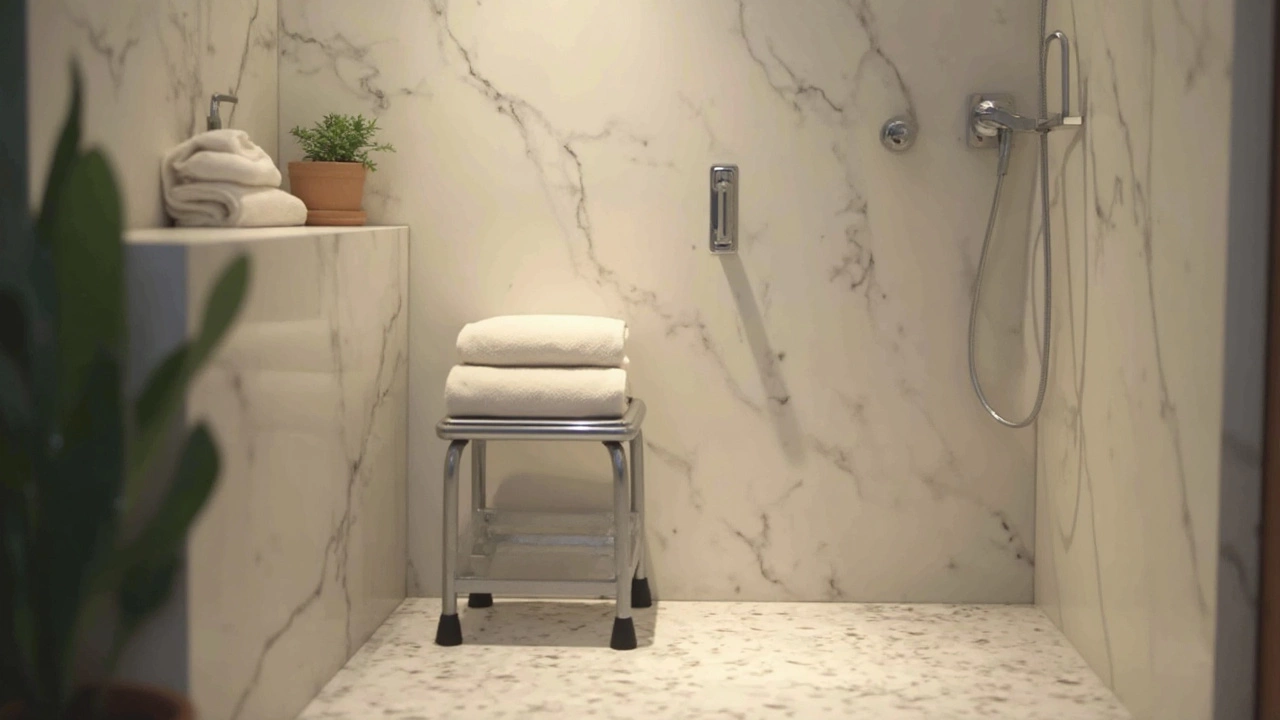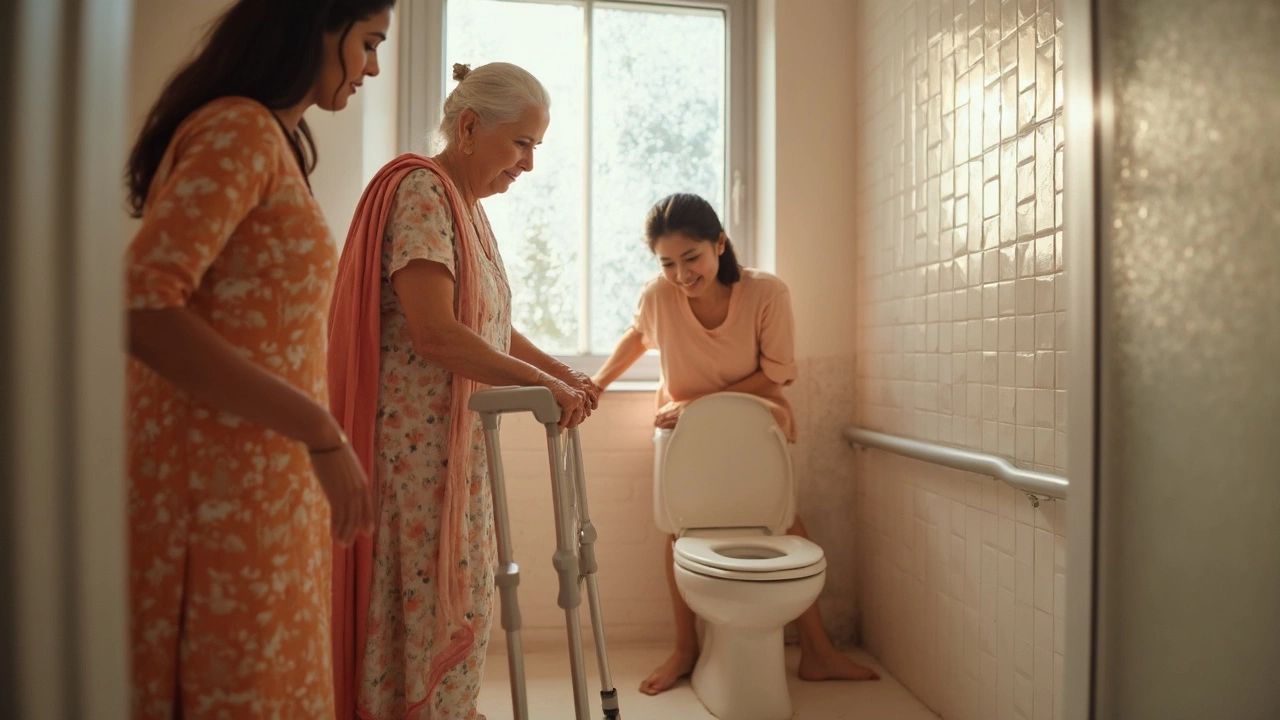Peeing might sound like the easiest thing in the world—until you’ve just had knee replacement surgery. Suddenly, even getting to the bathroom feels like a mission. You can’t bend, squat, or rush like before. Everyone worries about this, even the ones who won’t admit it.
Most folks are caught off guard by how tough the first bathroom trips are. That first urge hits, and you realize hopping over isn’t an option. You'll need a safe plan, or you might risk a painful fall.
So, here’s what matters: set up your bathroom with what you need before surgery. Things like a raised toilet seat, sturdy support bars, and an easy path from your bed to the toilet can make a world of difference.
Some people get creative with bedside commodes, if walking to the main bathroom isn’t possible. Female urinals and male handheld urinals are actually more useful than you think. The real trick is to avoid trying to tough it out and instead, make it as easy on yourself as possible.
There’s no shame in asking for help or using what you need; the alternative—hurting your new knee or ending up embarrassed—just isn’t worth it. Ready to make those first days easier? Let’s break down the bathroom side of knee recovery, step by step, so you can focus on healing, not worrying about where to pee.
- Why Peeing Is Tough After Knee Surgery
- Setting Up Your Bathroom for Success
- Best Tools and Gadgets for Easy Bathroom Trips
- How to Use the Toilet Safely—Step by Step
- Managing Pain and Swelling While Using the Bathroom
- Pro Tips: Keeping Your Dignity (and Sanity) Intact
Why Peeing Is Tough After Knee Surgery
Most people don’t realize just how much you use your knees for simple stuff until you have a brand new one. After knee replacement, every movement can hurt—especially when it’s time to use the toilet.
Here’s what messes with your usual bathroom routine:
- Pain and Swelling: Moving your leg can send sharp pain through your knee joint. Swelling makes it tough to bend or even put weight on your new knee.
- Limited Range of Motion: Right after surgery, you might not be able to bend your knee much at all. Low toilets, tight spaces, and awkward angles become a real problem.
- Weakness and Wobbly Legs: Your leg muscles are recovering, and you probably don’t trust your balance. Grabbing onto things and moving slow is the new normal, especially those first days.
- Medications: The anesthesia and painkillers you got during and after surgery can make you groggy or dizzy. Less focus + wobbly legs = one risky trip to the toilet.
- Bathroom Setup: If your home bathroom isn’t set up for limited mobility, just getting to the toilet or sitting down can be a struggle.
And let’s not forget—some folks worry so much about the pain or falling that they put off peeing, which just makes things worse. In fact, studies show about 20% of people have trouble with bathroom independence in the first week after knee surgery. Most report they feel unsteady getting on or off the toilet.
| Obstacle | How Common? |
|---|---|
| Pain bending knee | Nearly everyone (Day 1-3) |
| Buckling or unsteady legs | Over 40% (first week) |
| Needing help to stand up | About 1 in 3 in first days |
| Afraid of falling | Almost half report some fear |
Bottom line: peeing after knee surgery is no joke. It’s not just awkward—it can be a safety risk. That’s why having a good plan (and the right tools) really matters those first days at home.
Setting Up Your Bathroom for Success
The bathroom isn’t usually the first place you think of getting hurt, but after knee replacement, a simple slip here can mean a trip back to the hospital. Key point: you have to plan ahead. A few smart tweaks can make a huge difference in your comfort and safety—especially for those first two weeks when your knee is stiff and your balance isn’t great.
Your bathroom should be clear of clutter—think old bath mats, scale, baskets, and anything that could trip you up. Make sure the pathway from your bed to the toilet is totally open. It’s not just about space, it’s about making it easy to move, even at 3 a.m. when you’re half-awake and hurting.
Most surgeons and physical therapists recommend these basics for bathroom safety right after knee surgery:
- Raised toilet seat – Lifts up your seat by a few inches so you don’t have to squat as low. Your new knee will thank you.
- Grab bars – Install one by the toilet for extra support. No, your towel rack does not count. It needs to be sturdy and bolted to the wall.
- Non-slip mats – A slippery floor is the enemy. Use thick, non-skid mats (not fluffy bathroom rugs) in front of both toilet and sink.
- Night light – Navigating in the dark? Bad idea. A bright, motion-sensing light can keep you upright.
- Walker-accessible space – If you’re using a walker, wide doors and clear corners matter. Measure out at least 32 inches of clearance.
- Hand-held urinal or commode – For those rough first days when making it to the toilet just isn’t happening.
Here’s what hospitals and home health services rate as the most useful bathroom gear for new knee patients:
| Item | Helps With | Percent of Patients Who Used It |
|---|---|---|
| Raised Toilet Seat | Avoiding deep bend and pain | 72% |
| Grab Bars | Balance and stability | 65% |
| Non-Slip Mats | Preventing falls | 59% |
| Portable Commode | Mobility issues at night | 34% |
| Night Light | Safe bathroom trips | 48% |
One last thing: stock up on extra toilet paper and things like flushable wet wipes. The less you have to twist or bend, the better. If your bathroom doesn’t make life easy, fix it before you go in for your surgery. You’ll be glad you did when nature calls and your knee’s not ready to answer.
Best Tools and Gadgets for Easy Bathroom Trips
Trying to reach the toilet after knee replacement? Don’t do it empty-handed. The right gear can spare you pain, give extra confidence, and make things much safer. Here’s what really helps when you’re dealing with limited movement right after surgery.
- Raised Toilet Seat: This is a must for anyone who can’t bend their knee fully yet. Raised seats attach to your regular toilet and add four to six inches of height, which means you don’t have to squat way down. Pharmacy chains and medical supply stores carry these, and you don’t need tools for most models.
- Toilet Safety Frame or Grab Bars: These sturdy handles sit on either side of the toilet and give you something solid to push on when you’re sitting or standing up. Skip the wobbly towel bar — these frames are made for actual body weight and won’t rip out of the wall.
- Bedside Commode: If your bedroom is far from the bathroom, or midnight walks sound like a bad idea, consider this. It’s basically a portable potty with a seat and bucket. It’s not glamorous, but it saves you some scary trips and lets you focus on healing.
- Handheld Urinal Bottles: Yes, they look weird, but a urinal bottle makes life a lot easier if you can’t stand well or can’t make it to the bathroom in time. They’re especially handy at night, and you’ll find versions for both men and women. Pro tip: keep one on your nightstand, just in case.
- Grabber Tools (Reachers): Bending down to pick up pants or toilet paper can be a nightmare. Grabber tools let you snag what you need without risking your knee.
If you’re shopping or putting together a care package, look for sturdy items from trusted medical suppliers. Avoid flimsy gadgets that might break when you lean on them. Even small changes — like putting non-slip mats on the bathroom floor — can help you feel more stable and reduce the chances of slipping.
Don’t forget hygiene: baby wipes, hand sanitizer, or a peri-bottle make cleaning up when reaching is hard a lot easier. It’s little stuff, but it can save your sanity and help keep recovery on track after your knee replacement.

How to Use the Toilet Safely—Step by Step
Right after knee replacement, the biggest bathroom mistake you can make is trying to do things the old way. Give it up—your knee won’t play nice just yet. Here’s how you do it safely, without wrecking your new joint or your confidence.
1. Prep Before You Move:
- Clear the path from your bed or chair to the bathroom. Shoelaces, towels, and rugs have sent plenty of people back to the hospital—no joke.
- Make sure you have a walker or sturdy crutches within arm’s reach. Don’t hop and don’t use regular furniture for support; it’s a recipe for disaster.
2. Approach the Toilet:
- Back up to the toilet until the back of your legs touch it. Never try to spin around or pivot on your new knee.
- Grip the grab bars, not the toilet paper holder (those things rip right out of the wall when you lean on them).
- Park your walker in front so it’s there for when you stand again.
3. Sitting Down Safely:
- Keep your surgical leg stretched slightly forward—never tuck it under you or bend it too tight.
- Using both hands, lower yourself slowly onto the seat. Use your arms more than your legs.
- Take your time. If your toilet feels too low, a raised seat can save a ton of hassle.
4. Doing Your Business:
- If using a urinal or bedside commode, keep it close and at a comfortable height.
- Some guys find it easier to stand if they use a urinal, but only if their balance is rock-solid. Otherwise, sitting is safer.
- Don’t rush. Getting up too quickly is when slips happen.
5. Standing Up Again:
- Plant both hands on the bars, not on your walker
- Push up with your strong leg and arms, keeping your surgical leg out in front again
- Grab your walker only after you’re fully upright and steady
Here’s a quick look at what most folks need for their post-surgery bathroom trips:
| Item | Why It Helps | Estimated Cost (USD) |
|---|---|---|
| Raised Toilet Seat | Reduces the amount you have to bend your knee | $30–$50 |
| Grab Bars | Gives real support for sitting and standing | $15–$40 per bar |
| Bedside Commode | Cuts out the walk to the bathroom at night | $50–$80 |
| Non-slip Bath Mat | Prevents falls—worth every penny | $10–$20 |
A little prep and patience go a long way. People who try shortcuts usually regret it—falls in the bathroom are the number one reason for unplanned hospital stays after a knee replacement. Take these steps and stick with them, and that first bathroom trip won’t be nearly as nerve-wracking.
Managing Pain and Swelling While Using the Bathroom
Pain and swelling can make a simple bathroom trip after knee replacement feel like running an obstacle course. The first few days are usually the hardest. Your knee is stiff, sore, and not up for any sudden moves. Most people notice swelling peaks between days 2 and 7 post-op. That’s exactly when you’ll be spending extra energy just getting up and down from the toilet.
Be honest with yourself: if you push through the pain, you’ll likely swell up more. The trick is to work smart, not hard. Keep these concrete tips in mind:
- Take pain meds about 30-45 minutes before bathroom trips whenever possible, especially if you’re on a schedule. That gives your medicine time to kick in and makes moving around easier.
- Use ice right after using the bathroom. A cold pack on the knee when you get back to your resting spot can help tame swelling and achiness.
- Keep your operated leg slightly extended when sitting, instead of forcing it to bend too much. An adjustable raised toilet seat can make this a lot easier.
- Get help if it hurts too much to stand, sit, or transfer your weight. Ask a family member to assist, or use a walker for support.
- Speed matters—don’t stand for long or try to “tough it out.” Most therapists suggest being on your feet for less than 5 minutes at a time in the first week.
Here's a quick table with stats about pain and swelling after this surgery:
| Day After Surgery | Average Pain Level (1-10) | Common Swelling Level |
|---|---|---|
| 1-2 | 6-8 | High |
| 3-5 | 5-7 | Peaks |
| 6-14 | 3-6 | Gradual Decrease |
If you ever feel dizzy or weak from pain meds, don’t use the bathroom alone. Safety always beats rushing. All these steps help a ton, but listening to your knee—seriously, don’t ignore it—gets you through bathroom trips with way fewer problems.
Pro Tips: Keeping Your Dignity (and Sanity) Intact
Bathroom stuff can feel awkward, so let’s be real—nobody wants to lose their cool or confidence every time they need to pee after a knee replacement. You don’t have to let a sore knee take over your sense of privacy or make you feel helpless. Here’s how people manage to keep things together, even when they can’t move like before.
- Plan ahead for privacy. Put supplies like wipes, hand sanitizer, and clean clothes within arm’s reach. This saves you from doing a dangerous balancing act just to grab a towel.
- Ask for help, but set boundaries. Some folks feel embarrassed asking for help, but letting a close friend or family member know what you need (and don’t need) makes things less awkward. Most helpers feel more comfortable if you tell them exactly how they can help.
- Master the “clothes shuffle.” Wear loose shorts or boxers that are easy to push down with one hand, so you don’t do a risky dance trying to undress. Skip belts, buttons, or anything tight for a week or two.
- Protect your new knee from water and germs. If you’re using a commode or urinal, keep a towel or clock handy for quick cleanups, and wipe down everything you touch.
- Boost confidence with gadgets. If you use a urinal, practice once before surgery (yep, it feels weird the first time, but you’ll get used to it). Raised seats and handles aren’t just for hospitals—they really help at home.
Doing your business slower than usual? Totally normal. Give yourself extra time and don’t rush. According to a 2023 hospital survey, about 80% of knee replacement patients reported taking over 10 minutes per bathroom trip for the first week at home, just to stay safe and steady. Check out the stats:
| First Week After Surgery | % of Patients Taking Extra Time |
|---|---|
| Taking 10+ mins in bathroom | 80% |
| Using special equipment | 65% |
| Needing occasional help | 50% |
Humor helps. Sometimes, laughing about how many gadgets you’ve got in the bathroom is the best way to not let frustration win. Keep a sense of humor, remind yourself it’s temporary, and trust that every trip gets a little easier. The key is to make your setup work for you—not the other way around.





